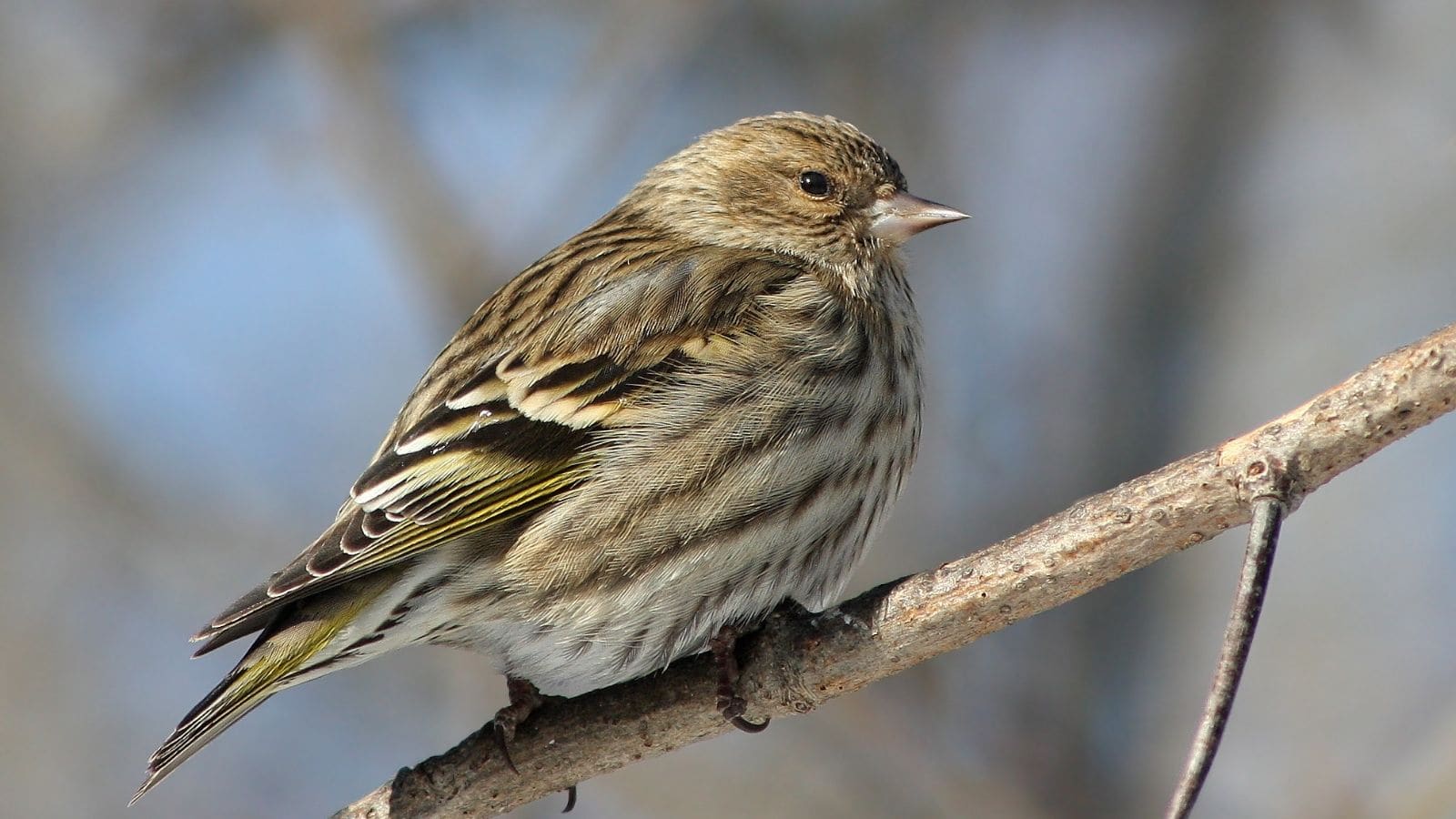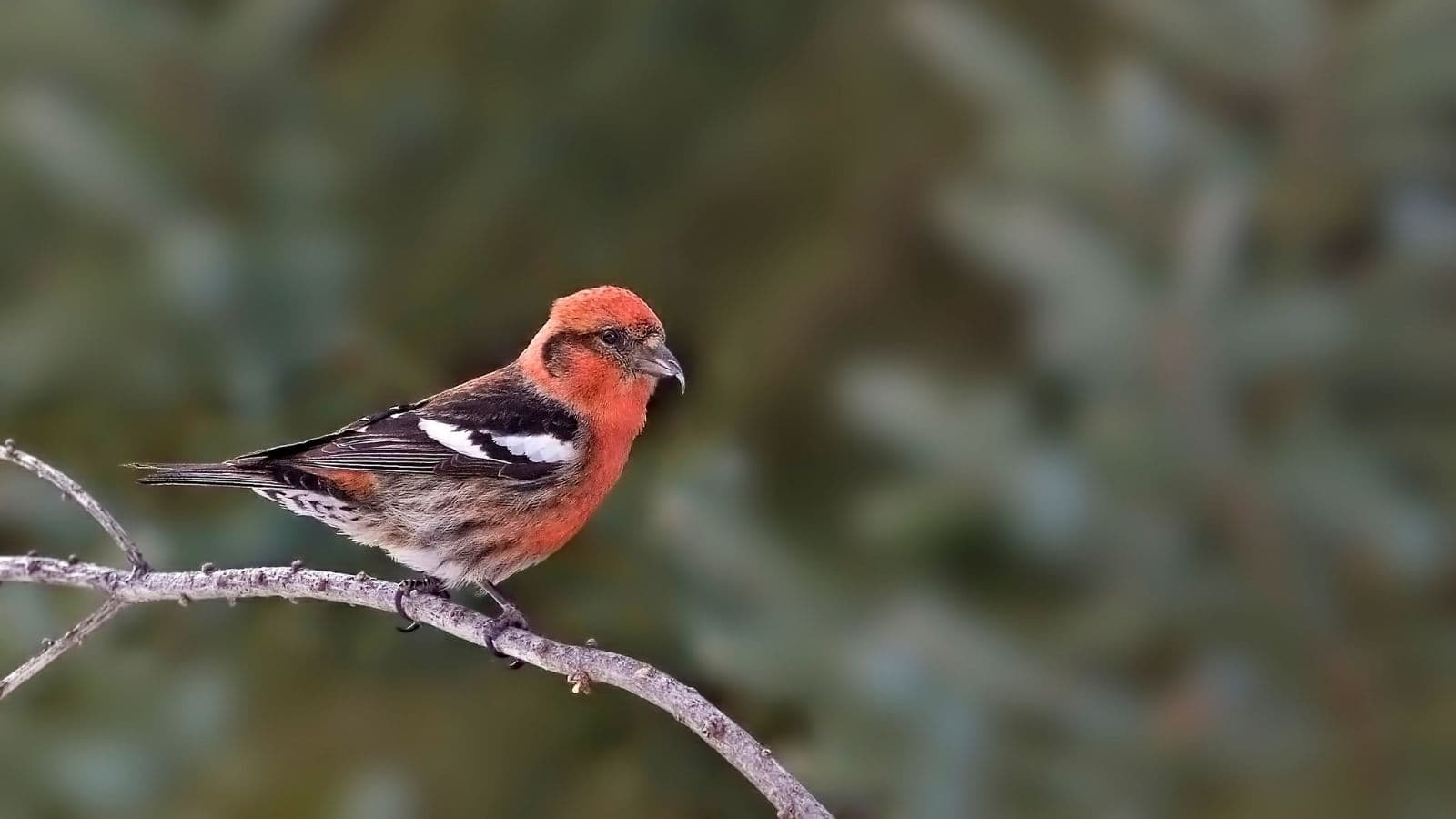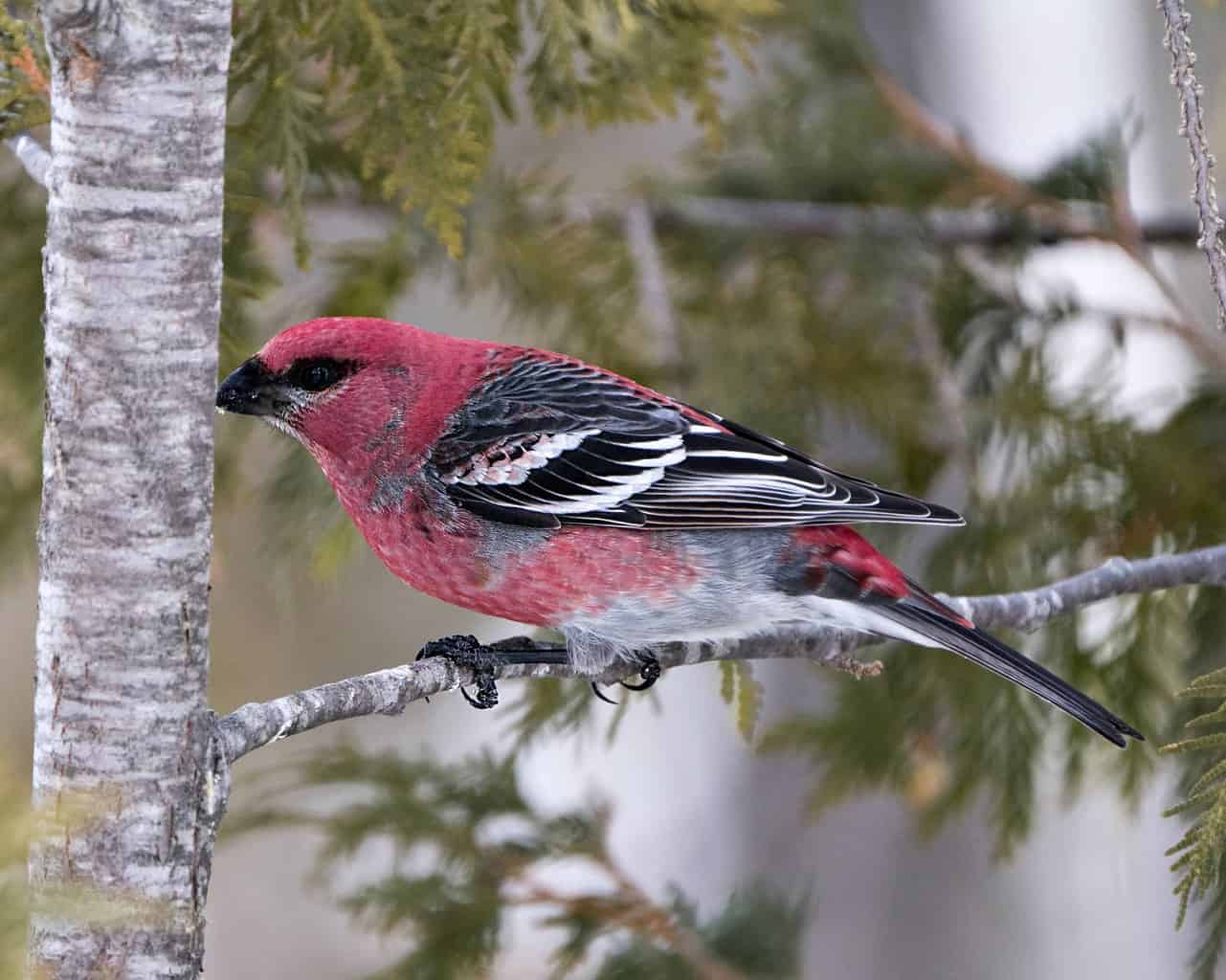A small Midwestern state, Indiana features many landscapes including till plains, rolling hills, deep river valleys, limestone caves, kettle lakes, sand dunes, and the shores of Lake Michigan in the north.
According to the Indiana Bird Records Committee (IBRC), there have been 422 species of bird reported here since records began. Several of those birds are finches, which are either permanent residents or migratory visitors.
Indiana lies towards the southern edge of many finch species’ winter range, but within the breeding grounds of a couple of species, too.
While finch flocks can be elusive and difficult to observe in the wild, Backyard bird feeders are a wonderful way to bring them closer to home. Oily seeds like black oil sunflower seeds and thistle seeds are firm favorite food items!
In this guide, you’ll learn where and when you can expect to find different finches, and how to identify them. We’ll start with the most commonly seen, everyday finches, before moving into the rarer nomadic explorers of the finch family.
Finches in Indiana, Starting With the Most Common
American Goldfinch

- Scientific Name: Spinus tristis
- Length: 4.3-5.1 in (11-13 cm)
- Weight: 0.4-0.7 oz (11-20 g)
- Wingspan: 7.5-8.7 in (19-22 cm)
American goldfinches are the most common finch in North America, and also the most common in Indiana. Male birds are especially stunning between March and October when they attempt to impress females with the bright yellow plumage that they’re named after.
American goldfinches are an extremely common bird year-round in Indiana where they frequent hedgerows, overgrown fields, orchards, and suburban gardens. During the breeding season, they’re listed in nearly half of all bird-watching reports here, falling to around one-third during the winter.
Nests are usually built among young trees or shrubs and formed from grass, tree bark, and feathers. The female lays four to six eggs which take ten to twelve days to hatch. The faithful male birds feed the females as they incubate the eggs.
American goldfinches are especially fond of thistle seeds (aka. nyjer seed), which is why some backyard birding enthusiasts have developed special thistle feeders to attract them and other finches to gardens.
House Finch

- Scientific Name: Haemorhous mexicanus
- Length: 5.1-5.5 in (13-14 cm)
- Weight: 0.6-0.9 oz (16-27 g)
- Wingspan: 7.9-9.8 in (20-25 cm)
House finches are the second most common finch in Indiana and are now nearly as widespread as American goldfinches across the continent – but it wasn’t always that way.
These adaptable birds were originally only native to the southwestern parts of the United States, but the introduction and release of caged birds in the 1940s led to their spread from New York City to the rest of the East.
They can now be found in suburbs, weedy fields, and open woodlands throughout Indiana in summer and winter. Sadly, their introduction has led to the displacement of some native finch species, especially the purple finch.
The bright red head, breast, and rump of the male house finch is their primary field mark and also what made them alluring as caged birds. Females are a drab, streaky brown throughout the year.
House finches are regular visitors at backyard feeders and possess a husky, tuneful warbling song that can help identify them.
Pine Siskin

- Scientific Name: Spinus Pinus
- Length: 4.3-5.5 in (11-14 cm)
- Weight: 0.4-0.6 oz (12-18 g)
- Wingspan: 7.1-8.7 in (18-22 cm)
Pine siskins are a common, migratory finch that can be found from Mexico to Alaska. They average 3% on birdwatcher report cards in winter and 1% in summer in Indiana, although their numbers vary considerably from year to year.
True to their name, pine siskins are often found in coniferous forests, but frequent mixed forests, too. They feed primarily upon seeds and buds of pines, hemlocks, alders, birches, and other trees. Their presence largely depends on the abundance of these crops in each locality.
Because their size and habit is similar to goldfinches, they could be confused for their relatives during the winter months. Pine siskins, however, have a more brown, streaky appearance and a narrower bill than any of the three native goldfinches.
Listen out for the metallic, rasping calls of pine siskins as they move through the tree canopy in search of food. This is another good way to tell them apart from the goldfinches that they often flock with.
Purple Finch

- Scientific Name: Haemorhous purpureus
- Length: 4.7-6.3 in (12-16 cm)
- Weight: 0.6-1.1 oz (18-32 g)
- Wingspan: 8.7-10.2 in (22-26 cm)
Remember how we said that purple finch numbers have been impacted by the introduction of house finches? Sadly, these beautiful birds have been affected by habitat loss and urban development, too.
Although they were once more common in Indiana, purple finches are now typically seen by less than 3% of birdwatchers during the winter and are very scarce here during the summer.
Like pine siskins, however, purple finch numbers vary considerably from year to year depending on food sources. They feed on a variety of foods and have been shown to do more good than harm in gardens where they feast upon pests like cutworms, lice, and weed seeds.
The purple finch’s scientific name ‘Haemorhous’ describes the blood-colored plumage of the male bird’s upper body that makes them especially attractive birds.
Common Redpoll

- Scientific Name: Acanthis flammea
- Length: 4.7-5.5 in (12-14 cm)
- Weight: 0.4-0.7 oz (11-20 g)
- Wingspan: 7.5-8.7 in (19-22 cm)
Common redpolls are nomadic birds that spend much of their lives at Northerly latitudes. While they can be found year-round as far north as Alaska and The Hudson Bay, some flocks migrate south in winter to more southerly regions, too.
According to Sibley’s Guide to Birds, the northern half of Indiana lies at the southernmost point of the common redpoll’s regular winter range. They’re recorded on nearly 1% of bird watcher’s reports here during the colder months, and will only occasionally venture to more southerly regions.
- Sibley Guide To Birds, 2nd Ed
- Sibley, David Allen (Author)
- English (Publication Language)
Last update on 2024-04-27 / Affiliate links / Images from Amazon Product Advertising API
Both male and female common redpolls are characterized by their ruby red caps, earning them their common name. Males also have an attractive deep pink chest, and both sexes have largely black and white streaked bodies and yellow bills.
Look out for common redpoll flocks feeding busily on birch catkins and weed seeds. Learning how to recognize their noisy chatter is a great way to locate and identify them.
Evening Grosbeak

- Scientific Name: Hesperiphona vespertina
- Length: 8 In (20cm)
- Weight: 2.1 Oz (60g)
- Wingspan: 14 inches (35cm)
Now moving onto the rarer finch species in Indiana, evening grosbeaks are only spotted by around 0.2% of birdwatchers during the winter months here, and much less than that during the summer.
But their scarcity here only makes them an even greater treat to spot. Evening grosbeaks are large, impressive finches with a bright yellow ring around their head and enormous bills.
Their bills are so strong that they can crack open seeds that other finches can’t manage. This formidable tool is what originally earned them their name – ‘gros bek’ meaning ‘fat beak’ in French!
When evening grosbeaks are seen in Indiana, they’re most commonly spotted in the north of the state during winter. This cold-hardy forest dweller is only commonly seen in the most northerly or mountainous regions of the US and mostly breeds in Canada.
Red Crossbill

- Scientific Name: Loxia curvirostra
- Length: 5.5-6.5 in (14-17 cm)
- Weight: 1.4 oz (40 g)
- Wingspan: 10-10.75 in (25-27 cm)
Whereas many finches in North America are not found on other continents, the red crossbill is a truly cosmopolitan bird. Scattered throughout Europe, Asia, and even North Africa, the red or ‘common crossbill’ travels far and wide in search of food.
Crossbills are so-called because of their unusual beaks that are crossed at the tips, allowing these specialists to extract seeds from conifer cones and other fruits.
Because of their love of pine kernels and similar seeds, flocks of crossbills are almost always found in conifer forests. Since Indiana doesn’t host so many conifers, crossbills are rarely seen here, although they are more common in neighboring Michigan.
Both male and female red crossbills are stunning birds. While a mature male’s color is true to their name, females mature into a lovely shade of green. Juveniles remain brown or yellow until their second year.
White-Winged Crossbill

- Scientific Name: Loxia leucoptera
- Length: 5.9-6.7 in (15-17 cm)
- Weight: 0.8-0.9 oz (24-26 g)
- Wingspan: 10.2-11.0 in (26-28 cm)
Now, if you see a crossbill in Illinois, you can’t automatically tick off the ‘red crossbill’ box on a report card. That’s because another species of crossbill lives here.
The white-winged crossbill, or ‘two-barred crossbill’ is similar in many ways to the previously described species, except they’re of a slightly slimmer build, have white patches on their wings, and females are yellowish rather than green.
Like their cousins, the red crossbills, white-winged crossbills are surprisingly tame and will often allow birdwatchers to approach them. Incredibly rewarding birds to photograph, they’ll often hang around upside-down on branches and let you get spectacular shots.
Two more fun facts about white-winged crossbills: they sometimes breed in the middle of winter, and can eat up to 3000 conifer seeds in a day. How about that for a fascinating bird!
Pine Grosbeak

- Scientific Name: Pinicola enucleator
- Length: 7.9-9.8 in (20-25 cm)
- Weight: 2.1 oz (60 g)
- Wingspan: 14.5 in (33 cm)
We mentioned earlier that evening grosbeaks are large finches, but there is one more titan that is even bigger. The pine grosbeak has an average wingspan of 14.5 inches across – larger than that of an Eastern Bluebird or Wood Thrush!
Indeed, pine grosbeaks are the largest of all the world’s finches and are stunning birds to behold. Moving slowly through forests in search of food, pine grosbeaks have a confident, thoughtful demeanor about them.
Both sexes have curved bills and long-notched tails. While males are red and gray, females are gray and green or russet.
Since they rarely travel this far south, Indiana residents might go their entire lives without seeing a pine grosbeak in the flesh. If you’re curious to know what to look out for, check out this excellent video of them visiting fruiting shrubs.
One That Got Away!
There’s one more finch species that can be seen in Indiana once in a blue moon.
Hoary redpolls (aka. Arctic redpolls) are close cousins of the common redpoll, but because they have even more of a northern range, they seldom travel this far south.
Only in years when food sources become very scarce in Canada will hoary redpolls visit the midwest. When they do, they’ll often arrive in mixed flocks with common redpolls, compared to whom they’re slightly paler and fluffier.
Conclusion
Indiana hosts its fair share of finches, and as you’ll now know, these fascinating bird species form a wonderfully rich and varied family.
Whether you’re an Indiana local or just passing through the state on a nature tour, don’t miss our guide to the state’s birds which includes cardinals, grackles, herons, hawks, and hummingbirds.

